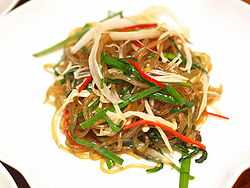Japchae
| Japchae | |
|---|---|
| Korean noodles | |
 | |
| Alternative name(s): | |
| |
| Place of origin: | |
| Korea | |
| Serving temperature: | |
| Hot or cold | |
| Main ingredient(s): | |
| Cellophane noodles, sesame oil, vegetables (carrots, onion, spinach, mushrooms) | |
| Recipes at Wikibooks: | |
|
| |
| Media at Wikimedia Commons: | |
|
|
| Japchae | |
| Hangul | 잡채 |
|---|---|
| Hanja | 雜菜 |
| Revised Romanization | japchae |
| McCune–Reischauer | chapch'ae |
Japchae, jabchae, chapchae, Chop Chae, or Chap Chae is a Korean dish made from sweet potato noodles (called dangmyeon, Korean: 당면), stir fried in sesame oil with various vegetables[1] (typically thinly sliced carrots, onion, spinach, and mushrooms), sometimes served with beef, and flavoured with soy sauce, and sweetened with sugar. It is usually served garnished with sesame seeds and slivers of chili. It may be served either hot or cold.
This dish is served at Korean parties and special occasions,[1] with seasonal vegetables added.
Japchae is most commonly served as a side dish, though it may be a main dish. It is often served on a bed of rice; together with rice it is known as japchae-bap (잡채밥), bap (밥) meaning "rice."
Etymology
The name, japchae, comprises the two hanja words; jap (hangul: 잡, hanja: 雜, literally "mixed and stirred") and chae (hangul: 채, hanja: 菜, literally "vegetables"). Therefore, japchae literally means "a mixture of vegetables."[2]
History
Japchae was first made in the early 17th century, when the Joseon Dynasty was reigning in the Korean peninsula. When King Gwanghaegun hosted a big party at his palace, one of his lieges, Yi Chung, created this dish to please the king’s palate. The king liked this dish so much that he rewarded his liege by promoting him to the position of hojo panseo (hangul: 호조판서, hanja: 戶曹判書, equivalent to the Secretary of the Treasury).[2] At the time, japchae was made with vegetables and mushrooms, such as sliced cucumber, shredded mu, and pyogo (shiitake) mushroom. Since the early 20th century, dangmyeon (cellophane noodles made from sweet potato starch) has become an integral and primary ingredient of this variety of japchae.
Types
Japchae was originally made without noodles and of various thinly shredded vegetables.[3]
Varieties without noodles
- Gochu japchae (고추잡채), made with shredded fresh green chili pepper and vegetables
- Buchu japchae (부추잡채), made with Korean chives
- Kongnamul japchae (콩나물잡채), made with kongnamul (soybean sprouts)
- Haemul japchae (해물잡채), made with seafood and vegetables
- Beoseot japchae (버섯잡채), made with mushrooms
Varieties served in Korean royal court cuisine
- Tangpyeongchae (탕평채), made with nokdumuk (mung bean starch jelly), sukjunamul (mung bean sprouts), watercress, red pepper, and various types of seaweed
- Gyeojachae (겨자채)
- Jokchae (족채), made with shredded jokpyeon (cow-hoof jelly) and vegetables
- Wolgwachae (월과채), made with zucchini, beef, pyogo (shiitake), chapssal bukkumi (찹쌀부꾸미, a pan-fried variety of tteok made of glutinous rice flour), and other vegetables.[4] "Wolgwa" (월과) refers to the Oriental pickling melon (Cucumis melo var. conomon) in the Korean language.[5] Nowadays zucchini has largely replaced wolgwa for making the dish due to the latter vegetable's rarity.
References
- ↑ 1.0 1.1 "Japchae". Korea Tourism Organization. Retrieved 2013-04-08.
- ↑ 2.0 2.1 오혜숙 (2006-05-23). "음식이야기 <34> 잡채" (in Korean). 국제신문. Archived from the original on 2008-04-12. Retrieved 2007-11-23.
- ↑ "잡채" (in Korean). Food in Korea. Retrieved 2008-05-06.
- ↑ "Bukkumi 부꾸미" (in Korean). Doosan Encyclopedia. Retrieved 2008-05-16.
- ↑ "Wolgwachae 월과채" (in Korean). Doosan Encyclopedia. Retrieved 2008-05-16.
- A Korean mother's cooking notes (Unknown Binding), by Son-yong Chang ISBN 89-7300-299-6
- 황환영. "잔치음식의 대표, 이것 없으면 섭섭" (in Korean). The Korean Times Daily. Retrieved 2007-11-23.
External links
| Look up japchae in Wiktionary, the free dictionary. |
| Wikimedia Commons has media related to Japchae. |
| ||||||||||||||||||||||||||||||||||||||||||